Health Articles
Find out more about your health here from our health professionals!
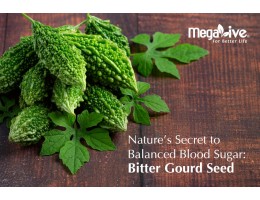
Nature’s Secret to Balanced Blood Sugar: Bitter Gourd Seed
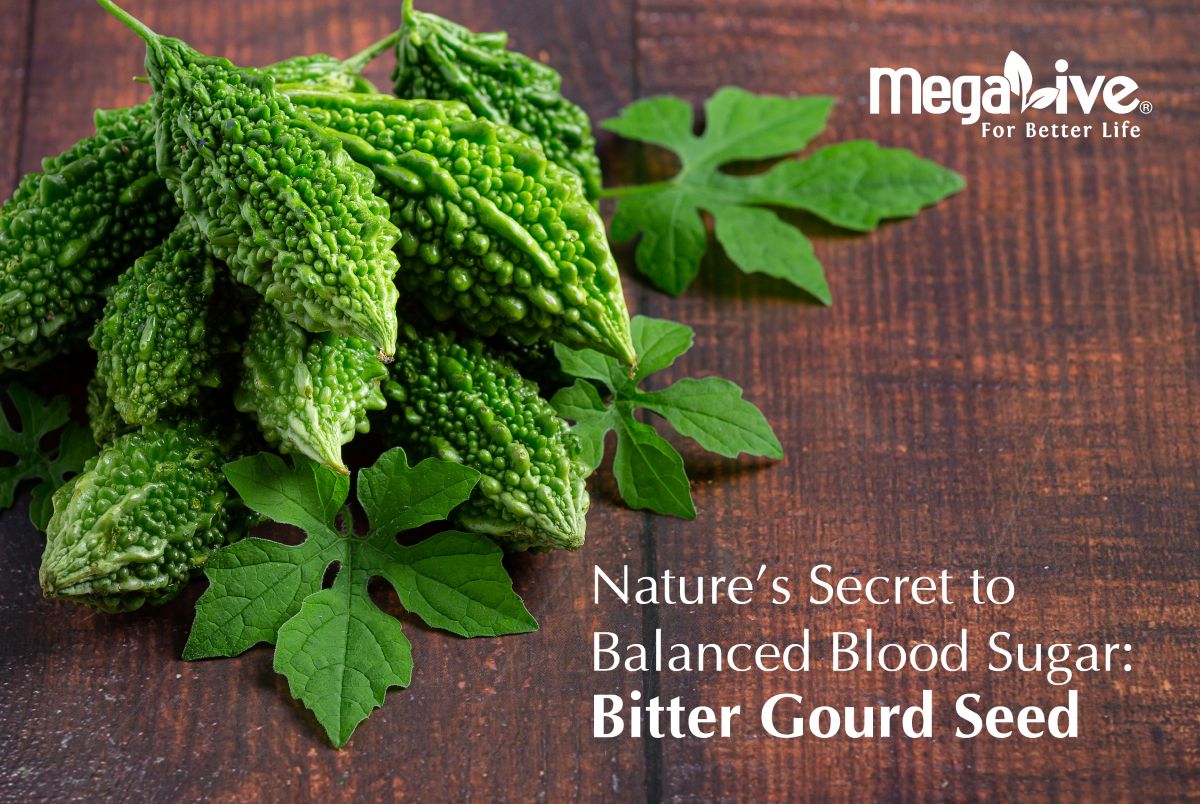
Polypeptide-K™ Bitter Melon Seed Extract is a natural protein extract derived from bitter gourd (known locally as peria katak or peria pahit), a traditional ingredient deeply rooted in Malaysian and Southeast Asian heritage. For generations, bitter gourd has been used in local remedies and home cooking for its health-supporting properties, especially in maintaining healthy blood sugar levels.
Supporting Blood Sugar Regulation
Polypeptide-K™ Bitter Melon Seed Extract has gained growing scientific interest for its potential to help regulate blood sugar naturally. It is believed to support the body’s insulin activity, offering a gentle, plant-based approach that complements modern diabetes management, which is particularly relevant as Malaysia continues to see rising cases of diabetes among adults.[1]
Improving Glucose Utilization and Metabolic Balance
Researchers suggest that Polypeptide-K™ Bitter Melon Seed Extract may help substitute missing amino acid links necessary for the formation of vital proteins such as insulin. This natural mechanism supports better glucose utilization and promotes overall metabolic balance, helping the body maintain steady energy levels throughout the day.[2]
Antioxidant Protection
Beyond its blood sugar benefits, Polypeptide-K™ Bitter Melon Seed Extract also provides antioxidant protection. These antioxidants may help defend pancreatic beta cells, the very cells responsible for producing insulin, from oxidative stress and damage. By protecting these cells, Polypeptide-K™ Bitter Melon Seed Extract supports the body’s long-term ability to regulate blood sugar effectively.[3]
In Malaysia, where diabetes and metabolic disorders are becoming increasingly common, natural ingredients like bitter gourd offer a valuable complement to healthy living. Alongside a balanced diet, regular exercise, and routine health check-ups, Polypeptide-K™ Bitter Melon Seed Extract supplementation could be part of a holistic approach to better blood sugar control and overall wellness.
Nature continues to remind us that some of the most powerful health solutions come from the simplest local sources, and peria katak may just be one of them.
References:
- Ramesh, A., & Kumar, S. (2021). Anti-diabetic activity of Polypeptide-K isolated from Momordica charantia, https://www.researchgate.net/publication/357562248_Anti-Diabetic_Activity_of_Polypeptide-K_Isolated_from_Momordica_Charantia_A_Retrospective_Study_of_142_Cases
- Basch, E., Gabardi, S., & Ulbricht, C. (2015). Bitter melon (Momordica charantia): A review of efficacy and safety. PubMed. https://pubmed.ncbi.nlm.nih.gov/26456213/
- Grover, J. K., & Yadav, S. (2018). Pharmacological actions and clinical efficacy of Polypeptide-K in diabetes management. PMC. https://www.ncbi.nlm.nih.gov/pmc/articles/PMC6268611/

How Alpha Lipoic Acid (ALA) Supports People Living with Diabetes
Diabetes is a long-term condition that affects how the body manages glucose, leading to persistently high blood sugar levels. Over time, uncontrolled blood sugar can damage nerves, blood vessels, and organs, impacting overall health and daily comfort. Managing diabetes is not just about controlling sugar levels; it is about protecting your body from the stress that high glucose can cause.
One nutrient that has been widely studied for its potential to support people with diabetes is Alpha Lipoic Acid (ALA), a natural antioxidant found in every cell of the body.
What Is Alpha Lipoic Acid (ALA)?
Alpha Lipoic Acid (ALA) is a unique antioxidant that plays a key role in converting glucose into energy. Unlike most antioxidants that work only in water (like Vitamin C) or fat (like Vitamin E), ALA is both water and fat soluble, allowing it to protect cells throughout the entire body, including the brain, nerves, and blood vessels.
Although your body produces small amounts of ALA naturally, supplementation can help provide stronger support for people managing diabetes or nerve health issues.
Improves Insulin Sensitivity
One of ALA’s most valuable benefits for diabetes management is its ability to enhance insulin sensitivity. This means it helps your body use glucose more efficiently, supporting better blood sugar balance.Studies show that ALA can help muscle cells absorb glucose more effectively, leading to improved energy use and potentially lower blood sugar levels, especially in people with type 2 diabetes.
Reduces Oxidative Stress
High blood sugar can trigger oxidative stress, which damages cells and contributes to many diabetes-related complications.ALA helps to neutralize free radicals, which are harmful molecules that cause cell damage, and also regenerates other antioxidants such as Vitamins C and E.This strengthens your body’s natural defense system and supports healthier circulation, metabolism, and overall cell protection.[1]
Supports Nerve Health and Reduces Neuropathy
For many people with diabetes, nerve pain (neuropathy) is a common and uncomfortable issue.ALA has been shown to improve nerve conduction, enhance blood flow to the nerves, and reduce burning, tingling, or numbness in the hands and feet.Clinical studies show that individuals taking ALA experienced noticeable relief in neuropathic symptoms compared to those on a placebo.[2]
Natural Food Sources of ALA
While ALA is found naturally in certain foods, the levels are quite low. Some dietary sources include: Spinach, Broccoli, Tomatoes, Organ meats (liver, heart) and Brewer’s yeast.[3]
In Summary
Alpha Lipoic Acid (ALA) offers multiple benefits for people with diabetes, from improving insulin function and reducing oxidative damage to protecting nerve health and supporting circulation. Combined with a balanced diet, regular physical activity, and proper medical care, ALA can be a valuable part of a holistic diabetes management plan that supports long-term health and vitality.
Reference:
1. Awoleye, M. O. (2024). Revisiting the molecular mechanisms of Alpha Lipoic Acid (ALA) actions on metabolism. Pharmacological Research – Natural Products. https://pmc.ncbi.nlm.nih.gov/articles/PMC2836194/
2. Packer, L., Witt, E. H., & Tritschler, H. J. (1995). Alpha-lipoic acid as a biological antioxidant. Free Radical Biology & Medicine. https://pubmed.ncbi.nlm.nih.gov/7649494/
3. Ziegler, D., Ametov, A., Barinov, A., Dyck, P. J., Gurieva, I., Low, P. A., … Yakhno, N. (2006). Oral treatment with α-lipoic acid improves symptomatic diabetic polyneuropathy: The SYDNEY 2 trial. Diabetes Care. https://diabetesjournals.org/care/article/29/11/2365/24539/Oral-Treatment-With-Lipoic-Acid-Improves

Are You Taking Care of Your Nerves? 3 Essential Ways to Protect Nerve Health Naturally
Are You Taking Care of Your Nerves? 3 Essential Ways to Protect Nerve Health Naturally
Your nervous system plays a vital role in how your body feels, moves, and responds to the world around you. However, modern lifestyle factors such as chronic stress, insufficient rest, poor diet, and inactivity can gradually affect nerve function. Protecting your nerves does not require complex interventions. Simple, consistent habits can make a meaningful difference over time.
1. Maintain an Active Lifestyle
Regular physical activity promotes healthy blood circulation, which ensures that your nerves receive sufficient oxygen and nutrients to function effectively. Exercise also helps reduce inflammation and supports better communication between nerve cells, improving both coordination and response time. Even gentle activities such as walking, yoga, or stretching can enhance nerve resilience and contribute to overall mobility and vitality.[1]
2. Manage Stress and Get Enough Rest
Chronic stress and inadequate sleep can lead to the overproduction of stress hormones, which may damage nerve cells over time. Allowing your mind and body to rest through relaxation techniques such as deep breathing, meditation, or mindfulness helps restore balance to the nervous system. Prioritizing consistent, quality sleep supports the body’s natural repair processes and helps maintain long-term nerve health. [2]
3. Nourish with Antioxidants like ALA (Alpha Lipoic Acid)
Alpha Lipoic Acid (ALA) is a powerful antioxidant that protects nerves from oxidative stress by neutralizing harmful free radicals. It also plays a role in energy metabolism, supporting glucose utilization that fuels nerve cell function. Research has shown that ALA may help relieve symptoms of peripheral neuropathy, making it a valuable nutrient for maintaining nerve strength and protection. [3]
Caring for your nerves is an ongoing journey toward better health and vitality. By combining nutritional support, regular movement, and sufficient rest, you can help your nerves perform at their best. Over time, these small, intentional habits can improve your energy, comfort, and overall quality of life.
References:
1.Fava, A., et al. (2013). The effect of lipoic acid therapy on cognitive functioning in patients with Alzheimer’s disease. Journal of Neurodegenerative Diseases, https://pmc.ncbi.nlm.nih.gov/articles/PMC10442603/#:~:text=It%20can%20improve%20memory%20and,of%20cognitive%20decline%20and%20dementia.
2.Irwin, M. R. (2015). Why sleep is important for health: A psychoneuroimmunology perspective. Annual Review of Psychology, https://pmc.ncbi.nlm.nih.gov/articles/PMC4961463/
3.Gomes, B. A. Q., dos Santos, S. M., Gato, L. da S., Espíndola, K. M. M., da Silva, R. K. M., Davis, K., Navegantes-Lima, K. C., Burbano, R. M. R., Romao, P. R. T., Coleman, M. D., & Monteiro, M. C. (2021). Alpha-lipoic acid reduces neuroinflammation and oxidative stress induced by dapsone in an animal model. Antioxidants, 10(2), 277. https://www.mdpi.com/2072-6643/17/5/791#:~:text=The%20beneficial%20effects%20of%20ALA,the%20changes%20caused%20by%20DDS.

Fruit juice: Is it really good for us?
To answer this, it really is a very tricky one. There are always two sides to a story when it comes to this. One believes that juicing is unhealthy than eating whole fruits due to the loss of fibre throughout the process, which makes fructose (sugar in fruit) absorb even quicker as compared to when it is combined with fibre, thus making it less healthy (1).
Another belief is that juicing is better than eating whole fruits and vegetables because the body can absorb them better and let the digestive tract rest from digesting fibre. If one considers blending fruit, that is even better since the edible fibre in it makes us feel full, so it promotes satiety (1).
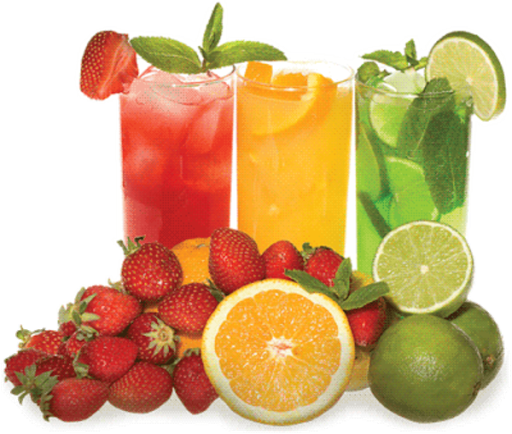
So should we consider juicing, blending, or just eating raw fruits and vegetables?
Three longitudinal prospective cohort studies found that greater consumption of fruits such as blueberries, grapes, apples, bananas, and grapefruit reduced the risk of type 2 diabetes, while greater consumption of fruit juice was associated with an increased risk of type 2 diabetes (2).
When fruit is squeezed for its juice, what is left inside is basically sugar, vitamins, and antioxidants such as carotenoids, etc.; thus, it is healthier in this aspect as compared to frizzy drinks (3). However, the amount of sugar inside both of these drinks is about the same, which is about 20–26 g of sugar per cup (3).
The reason why fruit juice contains a higher sugar content as compared to fresh fruit even when it is 100% fruit juice without the addition of anything else is because, for example, in order to make 250 ml of orange juice, two medium-sized oranges are needed, and that is only 250 ml. Since when it is in liquid form, people tend to consume it even more, thus more fruits are needed. As the number of fruits increases, so does the sugar in them, but not the fibre inside, which in turn makes them have loads of sugar (1, 3, 4, 7, 8).
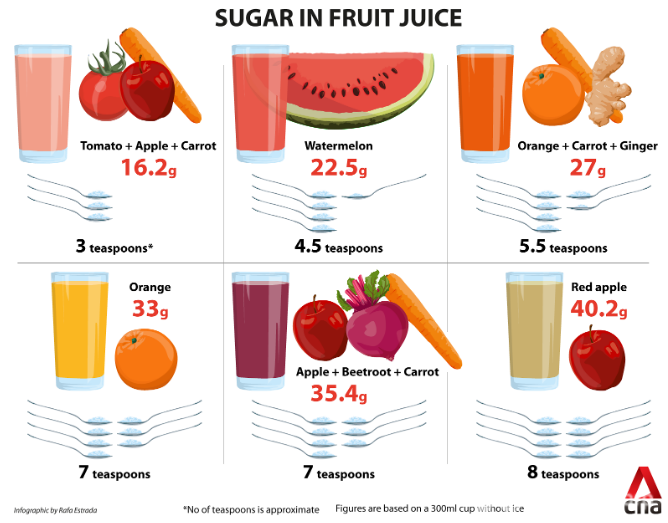
According to the Singapore Health Promotion Board, many people may think that naturally occurring sugar is healthier than added sugar, but actually there is no chemical difference between the two, and they have the same impact on blood sugar levels when ingested (8).
The same case goes to smoothies, not only because they have a lot of sugar from a large number of fruits, but also because various protein-based foods like yoghurt, milk, almond milk, etc. that are mixed together with them will increase their calories as well (4).
The high sugar levels in both of these drinks make them high-calorie beverages and thus pose the same effect as high-calorie food, which can lead to weight gain. As we know, Malaysia is the fattest country in Southeast Asia, and one of the contributing factors is a lack of knowledge on what can increase weight and what cannot.
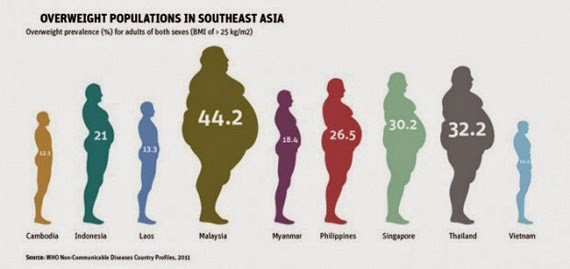
Weight gain is linked to many health problems, such as heart diseases, metabolic syndrome, cancer, bone and joint problems, kidney problems, etc. (3).
A study on the composition of grapefruits with different methods of household processing also found out that the composition of antioxidants in blended grapefruit has a higher concentration of the beneficial compound as compared to juicing or hand squeezing (5).

However, as for the absorption of beta carotene, a study found that fruit and vegetable juice makes beta carotene absorb better as compared to blending or eating raw fruit. This is due to the fact that fibre hinders the absorption of beta-carotene (6).
The takeaway message
Eating raw fruit, juicing, and blending all have their pros and cons. What is important is to always take into account the amount of sugar and fibre content. All in all, make sure that you have a balanced, nutritious, and moderate diet as suggested by the Ministry of Health: eat 3 servings of vegetables per day and 2 servings of fruits per day. Vary the way vegetables and fruit are cooked or served and eat them in moderation.
References
-
Mayo Clinic. https://www.mayoclinic.org/healthy-lifestyle/nutrition-and-healthy-eating/expert-answers/juicing/faq-20058020
-
MurakiIsao, ImamuraFumiaki, Manson JoAnn E, Hu Frank B, Willett Walter C, van Dam Rob M et al. Fruit consumption and risk of type 2 diabetes: results from three prospective longitudinal cohort studies BMJ 2013; 347 :f5001. https://www.bmj.com/content/347/bmj.f5001
-
Healthline (n.d). Is Fruit Juice is as Unhealthy as Sugary Soda? https://www.healthline.com/nutrition/fruit-juice-vs-soda#sugar-content
-
Healthline (n.d). Juicing vs Blending: Which one is better for me? https://www.healthline.com/health/food-nutrition/juicing-vs-blending
-
Ram M Uckoo1, Guddadarangavvanahally K Jayaprakasha, V M Balasubramaniam, Bhimanagouda S Patil. Grapefruit (Citrus Paradisi Macfad) Phytochemicals Composition Is Modulated by Household Processing Techniques.
-
Julia K Kolodziejczyk1, Shirley W Flatt, Loki Natarajan, Ruth Patterson, John P Pierce, Gregory J Norman. Associations of Soluble Fiber, Whole Fruits/Vegetables, and Juice With Plasma Beta-carotene Concentrations in a Free-Living Population of Breast Cancer Survivors. Women Health 52(8). DOI: 10.1080/03630242.2012.728189
-
How many orange does it take to make a cup of orange juice? (n.d). https://www.eatdifferentrd.com/blog/2016/8/12/how-many-oranges-does-it-take-to-make-a-cup-of-oj
-
Chanel News Asia (CNA) International (2019). That cup of fresh fruit juice could contain as much sugar as a soft drink. https://www.channelnewsasia.com/news/singapore/fruit-juice-sugar-diabetes-health-risks-soft-drink-11708652

How Much Sugar is Too Much Sugar?!
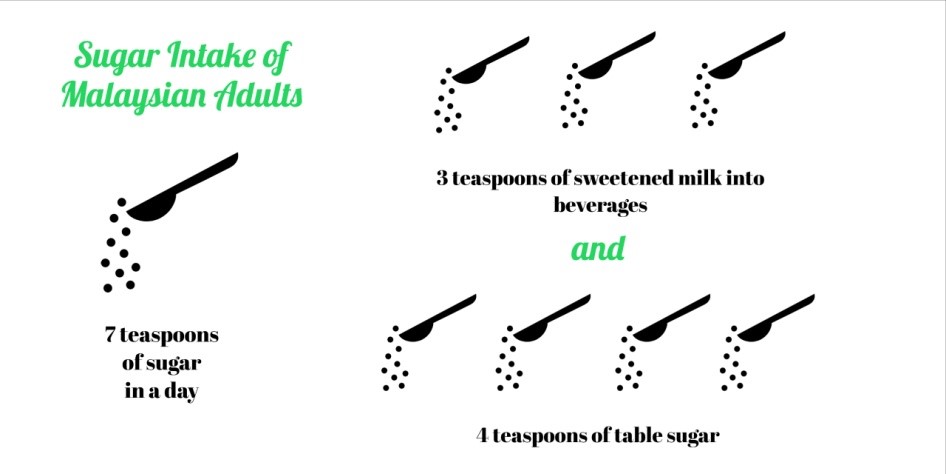
2015 World Health Statistics Report showed that in 2008, Malaysia had the highest obesity prevalence for adults aged ≥20 years among Southeast Asia countries. Increasing availability of sugar or sweeteners coupled with sedentary lifestyles are the contributing factor to Malaysia’s rising problem of obesity and other non-communicable disease problems (11).
On the other hand, Malaysian Adult Nutrition Survey (MANS) 2002/2003, average adult in Malaysia consumes 7 teaspoons of sugar a day comprising 4 teaspoons of table sugar and 3 teaspoons of sweetened milk into beverages. This amount exceeds the recommendation of the World Health Organization and Malaysian Dietary Guidelines (11).

Type of Sugar

Track your consumption of added sugar can be tricky, since packaged foods don’t list the number of teaspoons of sugar and some of us are getting our added sugar by spooning it onto our foods or into our beverages.
Here are the important numbers to remember:
There are 4 calories per gram of sugar and 4 grams per teaspoon. So if the label says it has 20 grams of sugar, that’s 5 teaspoons, or about 80 calories from sugar. Scan the labels for all sources of sugar in processed foods and check the number of grams of added sugars in the nutrition labels (5).
Artificial Sweeteners vs Sugar: Which is better?
Sugar substitute are known as a food additive that provides sweet taste like sugar without excess energy which can promote weight loss and deemed safe for consumption by diabetics (7). They can be either naturally produced or synthesized. Those sugar that are not natural are referred to as artificial sweeteners (9).
American Heart Association labels low-calorie sweeteners, artificial sweeteners and non-caloric sweeteners as non-nutritive sweeteners (NNSs), since they offer no nutritional benefits such as vitamins and minerals. Food and Drug Administration (FDA) has given the label “Generally Recognized as Safe” (GRAS) to five non-nutritive sweeteners such as aspartame, acesulfame-K, neotame, saccharin, sucralose and stevia. However, stevia doesn’t have a GRAS distinction but that doesn’t mean it’s dangerous, it just means there isn’t enough evidence yet either way (4).
Artificial sweeteners are thought to be beneficial for diabetics or obese as it provides sweetness without calories and a choice of sweets foods to those who cannot partake refined sugars. This artificial sweeteners may indeed restrict calories but their consumption has been shown to cause mild to serious side effects ranging from nuisance headaches to potentially life-threatening cancer.
However, artificial sweeteners are generally safe to consume but should be avoided by individual with phenylketonuria (a metabolic disorder which cannot metabolize amino acid phenylalanine found in aspartame or allergic to sulfonamides as saccharin belongs to this class of compound. In short, the consumption of artificial sweeteners may poses few health concerns but it is especially beneficial if you use them to decrease the amount of added sugar in diet. The likelihood of negative effects can vary by individual and depend on the type of artificial sweetener consumed (1). If you have bad experience or negative effects after consuming artificial sweeteners try natural sweeteners instead.
Get started cutting down on sugar with these tips
1. Consume foods or beverages low in sugar (3)
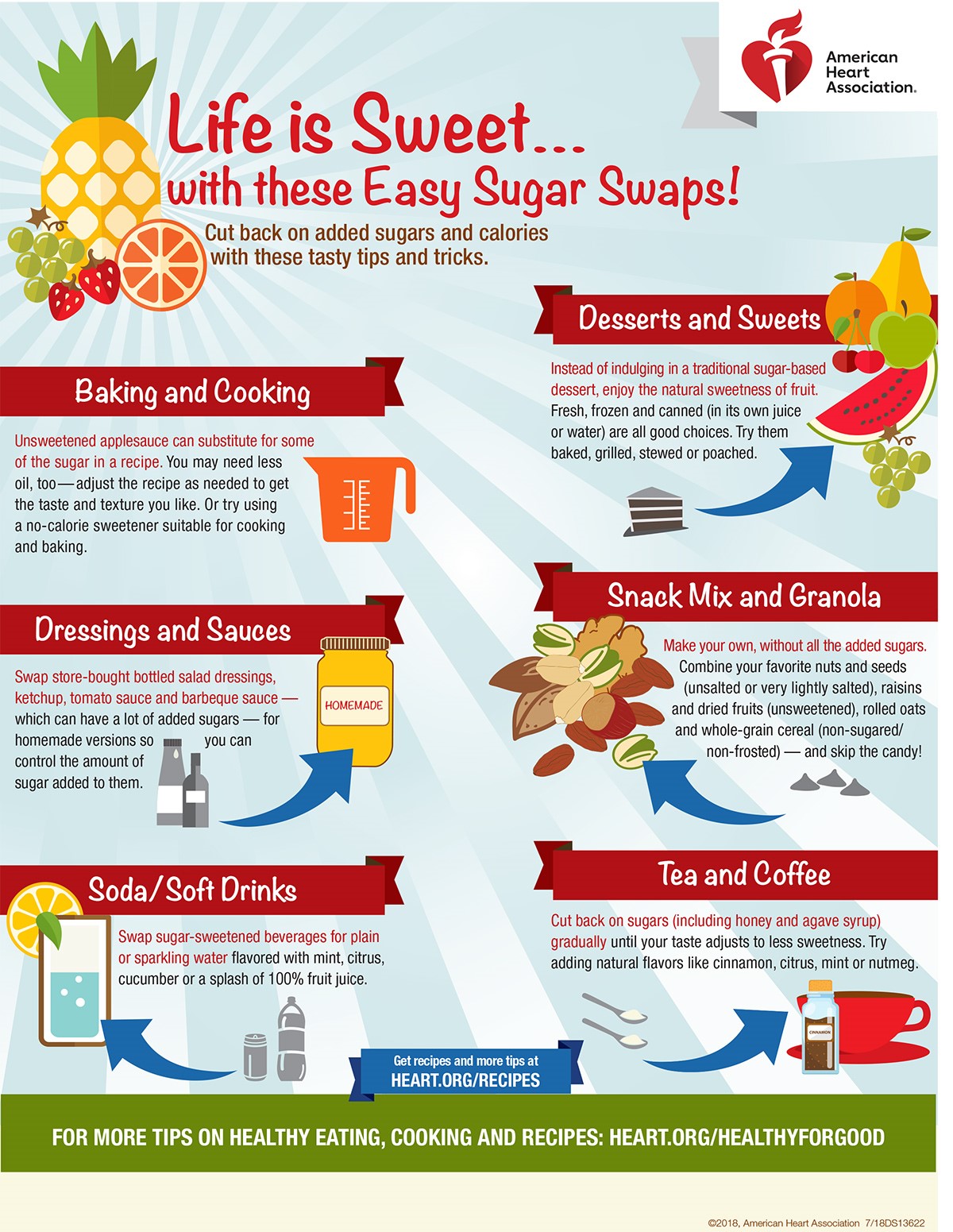
2. Focus on whole foods (8)
No sugar diet should focus on eating whole foods as processed foods are more likely to contain refined ingredients or added sugars. Aim to eat foods such as: Fruits and vegetables Lean meat or poultry whole, unprocessed grains and legumes, nuts and seeds
a)Reading the food labels and ingredients list on packaged food is a good way to know and limit how much added sugar you eat.
b) Identify the sugar content claims on packaged foods such as (6).
- Sugar Free: one serving contains less than 0.5g of sugars, both natural and added. Also: free of sugar, sugarless, no sugar, zero sugar or trivial source of sugar
- Reduced Sugar: Has at least 25% less sugars than the older version of the product. Also less sugar, low in sugar or lower sugar
- No Added Sugar: No sugar or ingredients containing sugar was added during processing or packaging. Also without added sugar or no sugar added.
References
- Alina, P. 2019. Artificial Sweeteners: Good or Bad? Healthline. Available from https://www.healthline.com/nutrition/artificial-sweeteners-good-or-bad [Accessed on 15 April 2020].
- American Heart Association. 2018. Added Sugars [online]. Available from https://www.heart.org/en/healthy-living/healthy-eating/eat-smart/sugar/added-sugars [Accessed on 15 April 2020].
- American Heart Association. 2018. Life is Sweet with These Easy Sugar Swaps-Info graphic [online]. Available from https://www.heart.org/en/healthy-living/healthy-eating/eat-smart/sugar/life-is-sweet-with-these-easy-sugar-swaps-infographic [Accessed on 15 April 2020].
- American Heart Association. 2018. Non-Nutritive Sweeteners (Artificial Sweeteners) [online]. Available from https://www.heart.org/en/healthy-living/healthy-eating/eat-smart/sugar/nonnutritive-sweeteners-artificial-sweeteners [Accessed on 15 April 2020].
- American Heart Association. 2019. By Any Other Name It’s Still Sweetener [online]. Available from https://www.heart.org/en/healthy-living/healthy-eating/eat-smart/sugar/by-any-other-name-its-still-sweetener [Accessed on 15 April 2020].
- American Heart Association. 2020. What’s the Difference Between Sugar Free and No Added Sugar [online]. Available from https://www.heart.org/en/healthy-living/healthy-eating/eat-smart/sugar/difference-between-sugar-free-and-no-added-sugar [Accessed on 15 April 2020].
- Arun, S., Amarnath, S., Thulasimani, M. and Ramaswamy, S. 2016. Artificial sweeteners as sugar substitute: Are they really safe? Indian Journal of Pharmacology 48(3): 237-240.
- Johnson, J. 2019. What to know about no-sugar diets. Medical New Today. Available from https://www.medicalnewstoday.com/articles/319991#why-cut-out-sugar [Accessed on 15 April 2020].
- Kirtida, R., T. 2011. Sugar substitutes: Health controversy over perceived benefits. Journal of Pharmacology & Pharmacotherapeutics 2(4): 236-243.
- Maria, S., V., A., Khor, G., L. and Pauline, C. 2016. Intake of added sugar in Malaysia: a review: Asia Pacific Journal of Clinical Nutrition 25(2): 227-240.
- MyHealth Ministry of Health. 2014. Facts About Sugar [online]. Available from http://www.myhealth.gov.my/en/facts-about-sugar/[Accessed on 15 April 2020].
- World Health Organization. 2015. WHO calls on countries to reduce sugars intake among adults and children [press release]. Available from https://www.who.int/mediacentre/news/releases/2015/sugar-guideline/en/ [Accessed on 15 April 2020].

Facts on Fiber
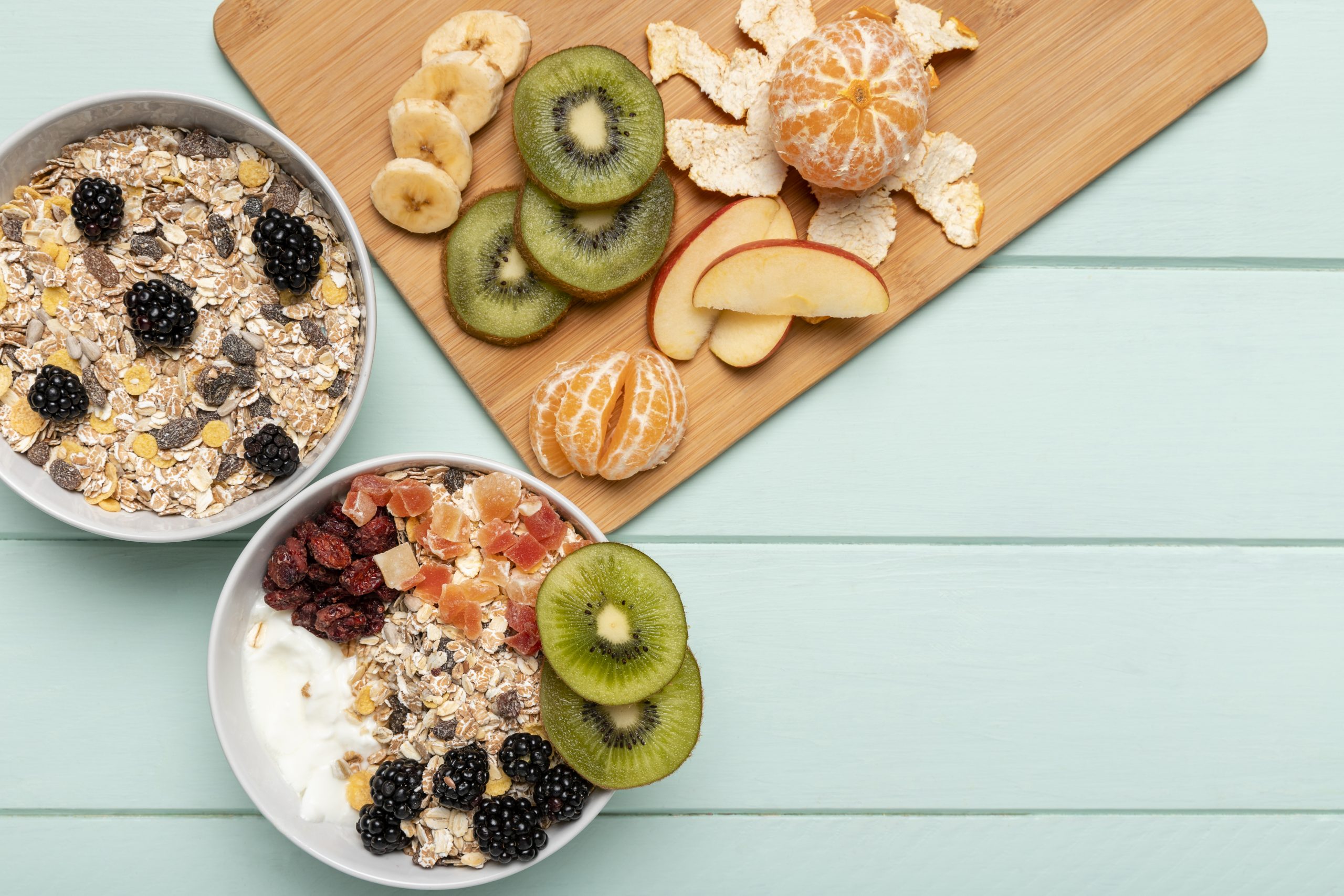
“Eat more vegetables and fruits to get your fiber!” You may have heard these words. But what is fiber, really? How it works to improve our health? Let us take a closer look on it!
Fiber is a type of carbohydrate that our body cannot digest undigested. Though most carbohydrates are broken down into sugar molecules but fiber cannot be broken down into sugar and thus it will pass through our body. These carbohydrates often considered beneficial in which mostly come from fruits, vegetables and legumes (1, 3, 6).

Soluble fiber
Dissolves in water; absorb water to form a gel like substance that slow the digestion and cause you to feel full. They have been shown to decrease cholesterol and lower blood glucose. Common source of soluble fiber includes beans, oat bran, fruits and vegetables. It is also found in pysllium, a common fiber supplement.
Insoluble fiber
Does not dissolve in water; Increase fecal bulk and appear to help food pass more quickly through the digestive tract so it can be of benefit to those who struggle with constipation and irregular stools.
Facts About Fiber (3,4)

#1 Fiber aids in achieving healthy weight.
#2 Fiber fight diseases. It appears to reduce risk of developing various health conditions including heart disease, diabetes, constipation and breast cancer.
#3 Fiber helps to lower cholesterol.
#4 Fiber helps to regulate blood glucose.
#5 Recommended dietary fiber intake per day for all age group is 20-30g/day. However, if a person is not currently eating enough of fiber, he or she should increase his or her fiber intake slowly to avoid gas and bloating.

#6 More fiber needs more water. When eating a high fiber diet, be sure to drink at least eight or more glasses of water every day.
#7 Fiber aids in improving digestion by increasing stool bulk and regularity. A high-fiber diet may help reduce the risk of hemorrhoids and diverticulitis.
#8 Too much fiber is a bad thing. You may experience abdominal cramping, bloating, gas, constipation and even diarrhea.
#9 Fruit and vegetable peels are rich in several nutrients including fiber. Eating unpeeled fruits and vegetables keep you feel full longer due to its high fiber content. However, certain fruit and vegetable peels may be hard to consume or simply inedible. These peels are best removed and not eaten.
#10 Fruits and vegetable juice has less fiber than whole fruits and vegetable. This is because the skin is removed and thus it is more healthful to eat whole fruit and vegetable.
#11 Fiber cannot be cooked out.
Tips to Increase fiber intake (5,7)
Consume products that have whole grain listed as the first ingredients, high fiber content and low fat and sugar content.
Replace white rice, bread and pasta with brown rice and whole grain products.
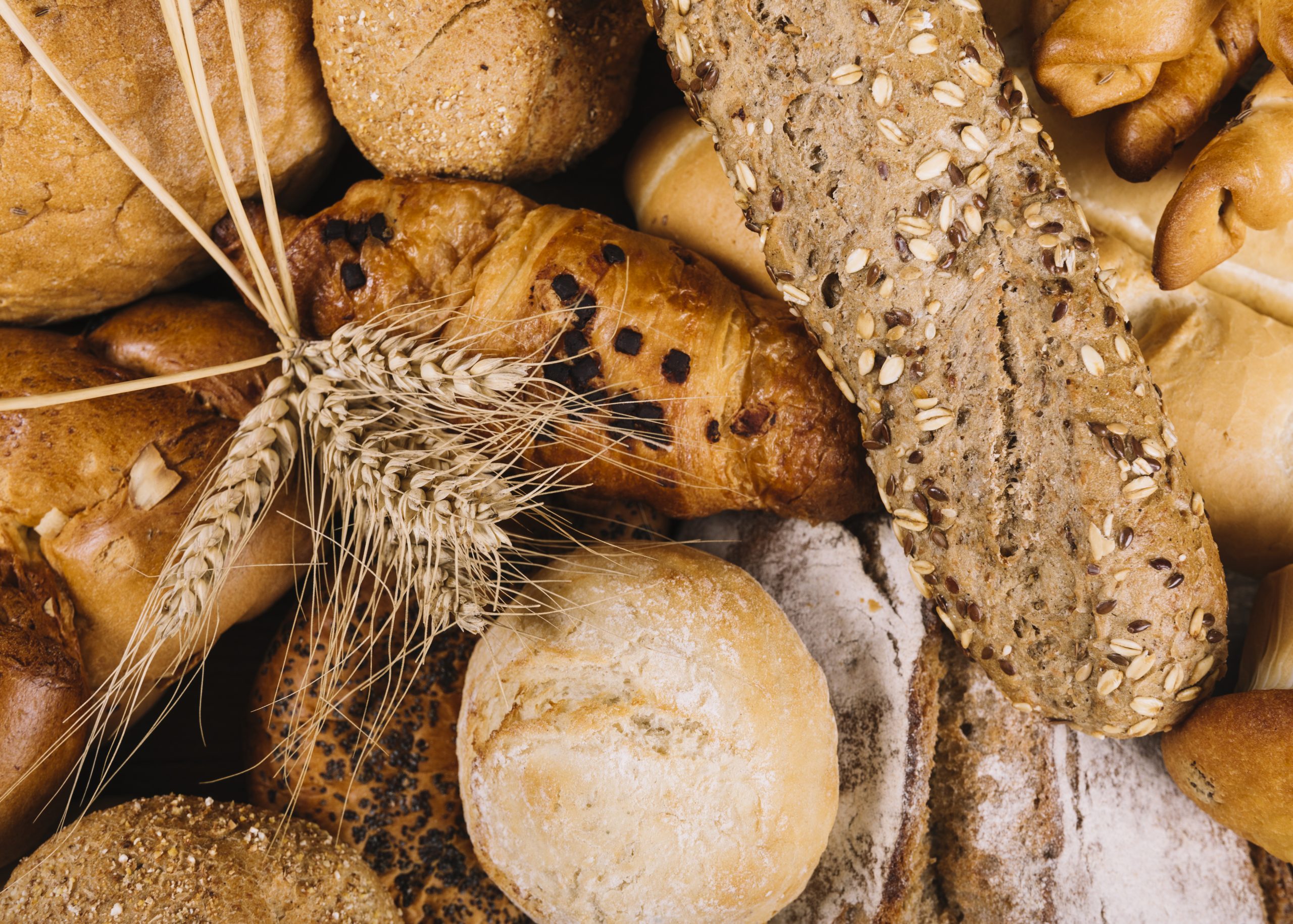
Include legumes in your diet (beans, dried peas and lentils)

Eat unpeeled whole fruit and vegetables not juice.
Snack on fruits and vegetables
Take a fiber supplement (e.g psyllium)
In conclusion,
Fiber is an important dietary substance to your diet. This is because high fiber foods are also good sources of vitamins, mineral and antioxidants which offer many health benefits. Therefore, as one of the key ingredients to healthy eating, fiber is something you cannot skip.
References
- Cleveland Clinic. 2019. Improving Your Health With Fiber. Available from https://my.clevelandclinic.org/health/articles/14400-improving-your-health-with-fiber [Accessed on 23 April 2020].
- Danielle, D. 2018. How much fiber is too much. Medical New Today. Available from https://www.medicalnewstoday.com/articles/321286#treatment [Accessed on 23 April 2020].
- Harvard University School of Public Health. (n.d.). Fiber. Available from https://www.hsph.harvard.edu/nutritionsource/carbohydrates/fiber/ [Accessed on 23 April 2020].
- Karin, L. 2016. 45 Interesting Facts about FIber. Fact Retriever. Available from https://www.factretriever.com/fiber-facts [Accessed on 23 April 2020].
- Kerri, A., J. 2016. 16 Easy Ways to Eat More Fiber. Healthline. Available from https://www.healthline.com/nutrition/16-ways-to-eat-more-fiber [Accessed on 23 April 2020].
- Mayo Clinic. 2018. Dietary fiber: Essential for a healthy diet. Available from https://www.mayoclinic.org/healthy-lifestyle/nutrition-and-healthy-eating/in-depth/fiber/art-20043983 [Accessed on 23 April 2020].
- My Health Ministry of Health. 2012. SERAT DAN KAWALAN DIABETES. Available from http://www.myhealth.gov.my/serat-dan-kawalan-diabetes/ [Accessed on 23 April 2020].

Diabetic Neuropathy
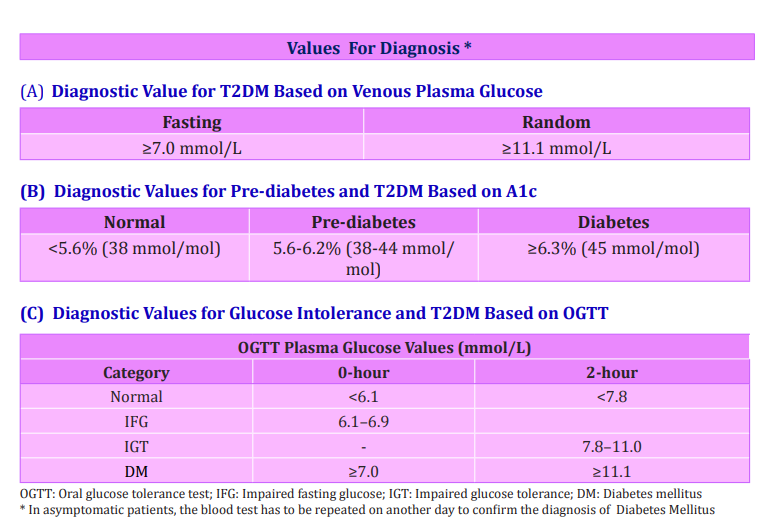
Blood glucose is the primary source of energy, and it is derived from the food that we eat. To convert this energy from food that we consume to cells, our bodies require a hormone called insulin, which is produced in the pancreas. With the help of this insulin hormone, energy from food is then converted into cells. When the body is unable to produce enough or any insulin, or when insulin is not used effectively, glucose or sugar remains in the blood and does not reach the cells (2).
Too much glucose in the blood can cause health problems over time. Although there is no cure for diabetes, individuals can take steps to manage their diabetes and stay healthy. Diabetes complications include cardiovascular disease, diabetes neuropathy (nerve damage), nephropathy (kidney damage), retinopathy (eye damage), and many others.
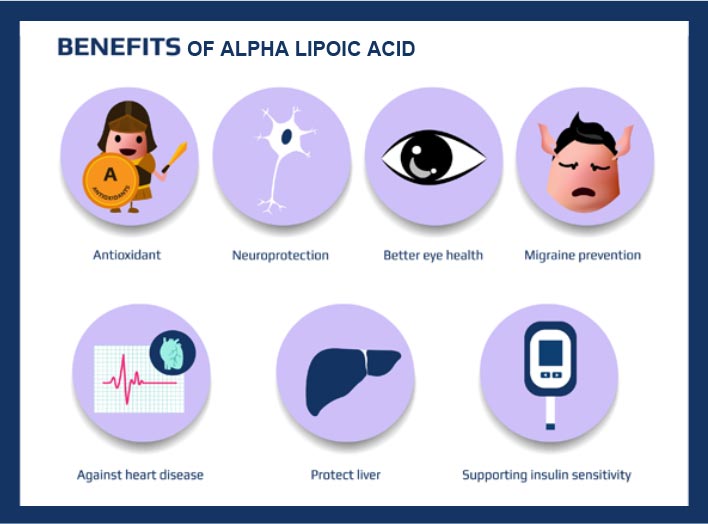
In this article, we will concentrate on the complication of nerve damage, also known as neuropathy. Excess sugar can cause damage to the walls of the tiny blood vessels (capillaries) that nourish nerves, particularly in the legs. This can cause tingling, numbness, burning, or pain, which usually starts at the tips of the toes or fingers and spreads upward. If left untreated, the individual may lose all feeling in the affected limbs (4).
Many studies are being conducted in an effort to reduce the risk of diabetic neuropathy complications, one of which is the use of Alpha Lipoic Acid (ALA). ALA is a type of antioxidant found in a variety of foods, but in very small amounts. Foods containing it include spinach, broccoli, yams, tomatoes, potatoes, carrots, beets, and rice bran. Whereas in animal-based food, the heart, liver, and kidney have higher concentrations of lipoic acid (LA) (5).
Lipoic acid (LA) can be synthesized by the human body in the liver. LA or ALA performs functions such as glucose and lipid metabolism, anti-inflammation, antioxidant property that can be used to regenerate other antioxidants, protein repair, and metal ion chelation. ALA, on the other hand, increases insulin sensitivity in people with diabetes (6).
As an antioxidant, ALA or LA aids in the fight against free radicals or oxidative stress caused by three pathways in the body of people with diabetes mellitus: mitochondrial, enzymatic, and non-enzymatic. Concerning the function of ALA in diabetes, several clinical trials have discovered that ALA may increase insulin sensitivity and help to reduce blood sugar and lipid levels.
There are two detailed studies involving this, in which ALA is administered for two weeks to 22 patients and improvements in fasting and average glucose levels, insulin sensitivity, LDL and HDL, and total cholesterol are seen, but the study is too short to measure the HBa1C level. So, another study related to this is the one that administered ALA orally to 74 patients for 4 weeks and discovered improvements in insulin resistance and fasting glucose (7).
Regarding the sole function of ALA on diabetic neuropathy, it is a possible alternative treatment for diabetic neuropathy. Diabetes causes neuropathy, or nerve damage, which is a permanent and common complication. However, ALA can help to alleviate the symptoms (8).
There are two types of neuropathy, the first of which is peripheral neuropathy, which most commonly occurs in the feet and legs but can also sometimes occur in the hands and arms. It can also cause numbness or the inability to feel changes in temperature, tingling or burning sensations, muscle weakness, a loss of balance, foot problems including ulcers or infections, sharp pain, or cramps. Whereas autonomic neuropathy can affect your autonomic nervous system, such as your heart, bladder, lungs, stomach, and intestines, this includes difficulty swallowing, constipation or uncontrollable diarrhea, bladder problems, erectile dysfunction, a decrease or increase in sweating, sharp drops in blood pressure, and many more (8).
In conclusion, studies show that ALA is able to help alleviate the symptoms of diabetes and diabetic neuropathy. However, the right management of diabetes, such as the intake of its medication, such as metformin, and diet control, together with physical activity, must be done side by side.
References
- National Institute if Diabetes, Digestive and Kidney Disease (NIDDK). United States Department of Health and Human Services. What is Diabetes? https://www.niddk.nih.gov/health-information/diabetes/overview/what-is-diabetes#:~:text=Diabetes%20is%20a%20disease%20that,to%20be%20used%20for%20energy. (Accessed on June 16, 2020).
- National Diabetes Institute of Malaysia (NADI). https://www.diabetesmalaysia.com.my/article.php?aid=8#:~:text=Your%20target%20blood%20glucose%20levels,in%20the%20last%203%20months. (Accessed on June 16, 2020).
- Clinical Practice Guideline (CPG) for Management of Diabetes Mellitus Type 2. 5th Ministry of Health Malaysia (MOH). https://www.moh.gov.my/moh/resources/Penerbitan/CPG/Endocrine/3b.pdf (Accessed on June 16, 2020).
- Mayo Clinic. Diabetes. https://www.mayoclinic.org/diseases-conditions/diabetes/symptoms-causes/syc-20371444 (Accessed on June 16, 2020).
- Alpha Lipoic Acid Supplement. https://www.webmd.com/diabetes/supplement-guide-alpha-lipoic-acid (Accesed on June 16, 2020).
- Saeid Golbidi, Mohammad Badran and Ismail Laher. Diabetes and Alpha Lipoic Acid (2011). Frontiers in Pharmacology. Journal of Pharmacology.NCBI. DOI 10.3389/fphar.2011.00069
- Diabetes Action. Alpha Lipoic Acid. https://diabetesaction.org/article-alpha-lipoic-acid#:~:text=While%20most%20of%20the%20research,of%20oxidative%20stress%20and%20inflammation. (Accessed on June 16, 2020).
- Alpha Lipoic Acid (ALA) and Diabetic Neuropathy. https://www.healthline.com/health/alpha-lipoic-acid-and-diabetes (Accessed on June 16, 2020).

DURIAN!!! Eat whole durian is equivalent to 3 bowl of rice?
Durian or ‘King of fruit’ is a well-known fruit for its smell. Anthony Bourdain, the late renowned food critic describes durian as “It smelled like you buried someone holding a big wheel of Stilton (cheese) in his arms, then dug him few weeks later” (1). That is to describe how horrible the smell of durian is, but to certain people who like to eat durian the smell of durian to them is heaven!
Durian actually has more than 30 species but the one that people usually eat are about 8 species only, due to its exotic nature, people have started to commercialized durian even to the international level. The most common durian being exported and widely consumed is Durio Zibethinus (2).

Due to its popularity, people started to questioning about durian health benefits, whether it is good or bad for health? Unlike apple, orange, guava and many other common fruits where people always equate it to “an apple a day keeps the doctor away” which means, consuming all these fruits are going to make you healthier, since it is packed full with nutrients that is good for body. For durian, the opinion regarding its health effect is mixing, some people say that it is good for health and can even be used to alleviate infertility or PCOS, Polycystic Ovarian Syndrome and some people say that it is heaty thus cannot be consumed too much etc. (3).
In general, durian is considered a safe fruit to eat just like any other fruit, but since durian has high calorie value, thus it is not advisable to consume in large amount unlike other fruits. Look at the infographic below to understand, calorie in durian in comparison with other fruits (4).

Here is the calorie of durian per seeds, surprisingly eating 5 seeds of durian is equivalent to a bowl of rice! ANDDDD IF A DURIAN CONSISTS OF 15 SEEDS IT IS EQUIVALENT TO 3 BOWL OF RICE! Thus, the recommended intake of durian is only 2-3 seeds, which is equivalent to about per serving of fruits or 90 kcal.

Though, it is crystal clear here that it is safe to eat durian within recommended amount, but there are people who should be even more cautious in consuming durian, that is people who are obese, people who have diabetes and people who have kidney problem. As for people who are obese and diabetes, it is due to its high calorie, high carbohydrate and high fats value thus should be extra careful on the consumption of durian. Whereas for people with kidney problem or undergoing dialysis, due to high potassium content in durian and it is difficult for their body to excrete potassium, thus, they must avoid eating TOO MUCH durian at all cost (4)!

Apart from its high calorie content durian has many benefits as well. It has high antioxidant effect, which makes it a potent fruit to fight against cancer. Durian contains high vitamins, nutrients and organic chemicals that function as antioxidant. All these antioxidants are vital in scavenging the free radicals, that potentially mutated and becoming cancer cells. Which is why it is very important to consume food that is high in antioxidant. It also contains high vitamin C, vitamin B complex and vitamin E, as well as phytonutrients that battle cancerous cells (2).
Durian also, is found to helps in maintaining healthy bones due to its high potassium content. It can help in alleviating depression and sleeping problem, for it contain tryptophan – a natural sleep-inducing compound, that can increase level of serotonin and melatonin for better sleep and emotion management. Durian also contain high fibre which can aids in digestion and helps in infertility for it has high estrogen hormone for conceiving (2).
Albeit durian has many health benefits, when it comes to its consumption with other foods and beverages such as alcohol, it is said that it can interfere with liver function. In detail, durian contain sulphur-containing volatiles which can inhibit the enzyme aldehyde dehydrogenase (enzyme that helps in process alcohol), thus explaining why consuming durian together with alcohol is a deadly mixed (4).
As for the consumption of durian with paracetamol, there is no study on human has been conducted, so far. But there is study on lab rat regarding this. The study shows that, rat that receive paracetamol and durian gives sign of hypothermic effect (significant drop in temperature) thus explain that the two mixture is toxic. However, the mechanism of toxicity is still unknown. To be safe, it is not safe to consume durian together with paracetamol (5).
In conclusion, for people who does not have any health concerns, consume durian within the recommended intake and consume it in moderation, is very much advisable. While for those who have health concerns, eat durian very minimally, it is advisable to eat other types of fruit that have lower calorie count as compared to durian, but since it is in the season thus consume it very minimally with caution towards calorie intake from other food types as well is recommended.
References
- The Star. Benefits of eating durian? Its rich in antioxidant but its fattening (2019). https://www.thestar.com.my/lifestyle/health/2019/09/10/eating-durian-healthy-or-not/ (Accessed on June 17, 2020).
- Tan M.C & Shyamala A. (2018). Exploring the Nutritional Content and Benefits of Durian (Durio Zibethinus). Institute of Bioproduct Development, Universiti Teknologi Mara. https://www.utm.my/ibd/project/exploring-the-nutritional-contents-and-benefits-of-durian-durio zibethinus/#:~:text=Durian%20is%20widely%20celebrated%20for,and%20protect%20against%20cardiovascular%20diseases. (Accessed on June 17, 2020).
- Reshma M. Ansari (2016). Potential Use of Durian Fruit (Durio Zibenthinus linn) as an Adjunct to treat Infertility in Polycystic Ovarian Synrdome (PCOS). PubMed. https://pubmed.ncbi.nlm.nih.gov/26778225/ (Accessed on June 17, 2020).
- International Medical University (IMU). Can A Durian A Day Keep the Doctor Away? http://imunews.imu.edu.my/people/can-a-durian-a-day-keep-the-doctor-away/ (Accessed on June 17, 2020).
- A. Chua., H. Nurhaslina., S.H. Gan. (2008). Hyperthermic Effect of Durio Zibethinnus and Its Interaction with Paracetamol. https://pubmed.ncbi.nlm.nih.gov/19271022/#:~:text=Because%20durian%20(Durio%20zibethinus)%2C,a%20risk%20of%20toxic%20effects

L – Carnitine: Can It Improve Diabetes?
L-Carnitine is an amino acid that the body produces. L-carnitine assists the body in converting fat into energy. In other words, L-carnitine aids the body's energy production. L-carnitine is essential for heart and brain function, muscle movement, and a variety of other processes in the body (1).
How does it work?
Many studies have found that L-carnitine can improve insulin sensitivity. It improves insulin sensitivity, allowing the body to convert food into energy. Here's a general overview of how food is converted into energy or fat in the body.

Glycogen is created when food is consumed and stored in the body until it is needed again (2). Insulin is an enzyme that converts the glucose in the food into glycogen.


The Overall pathway
This is where L-carnitine plays its role. Mice fed a high-fat diet are able to lower their blood glucose levels when L-carnitine supplementation is given to them, as opposed to mice fed a high-fat diet without the supplement (3).
Another human study found the same result, which is that L-carnitine supplementation reduces insulin resistance and improves insulin sensitivity. The study also suggests that current diabetes patient management, which includes diet modification, medication administration, and physical activities, may be improved in the future with the consumption of supplements such as L-Carnitine (4). The study also suggests that consuming 3g of L-carnitine per day may improve diabetes symptoms, but this must be accompanied by medical professional consultation (4). However, some studies suggest that L-carnitine consumption may have some side effects, so the safe consumption level is less than 2g/day.
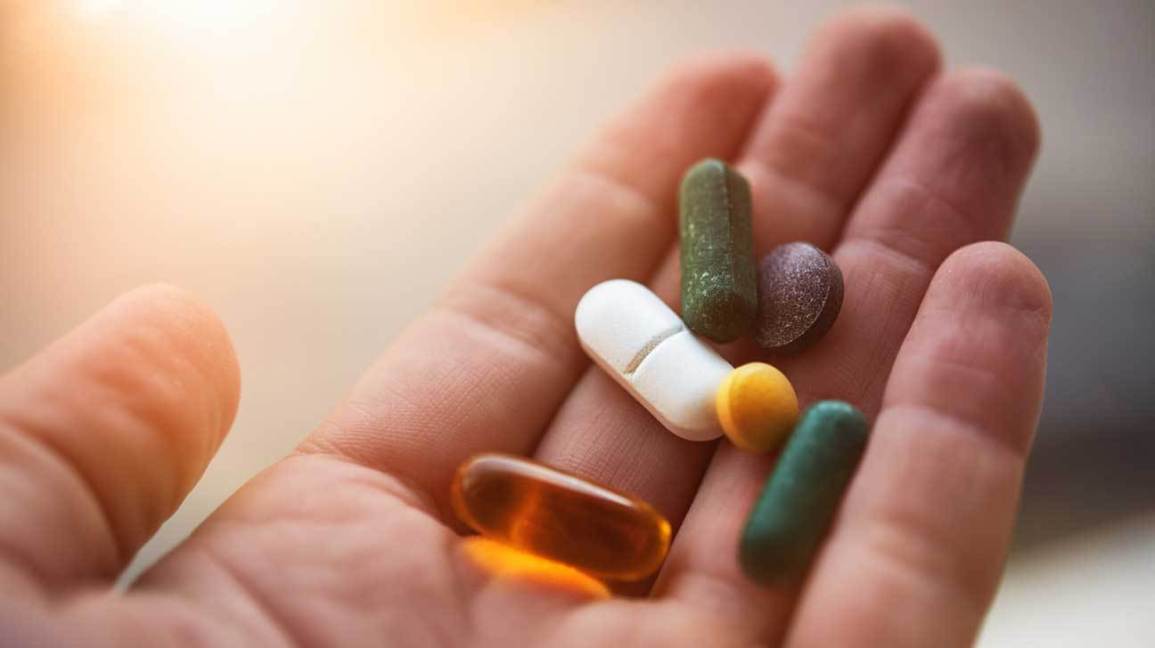
Due to the possibility that the general public might mistake it for a "magic pill" that would allow diabetes patients to eat whatever they wanted after taking it. The answer is no! A diabetes patient must still adhere to the diabetes diet, physical activity, and diabetes medication, but because diabetes is a progressive disease where the condition can worsen progressively, all actions, including supplement intake, may slow its progression (4).
Where can L-carnitine be found?
Apart from supplemented products, L-carnitines can be found naturally in foods such as beef and fish.
Beef: 81 mg/ 3 ounces
Pork: 24 mg/ 3 ounces
Fish: 5 mg/ 3 ounces
Chicken: 3 mg/ 3 ounces
Milk: 8 mg/ 3 ounces
References
-
WebMD. L – Carnitine. https://www.webmd.com/vitamins/ai/ingredientmono-1026/l-carnitine (Accessed on July 13, 2020).
-
Feedback Loop of Insulin and Glucagon. https://www.biologycorner.com/2017/08/22/feedback-loops-insulin-andglucagon/ (Accessed on July 13, 2020).
-
Randall L. Mynat (2009). Carnitine and Type 2 Diabetes. NCBI. PMC Journal. https://www.ncbi.nlm.nih.gov/pmc/articles/PMC5707127(Accessed on July 13, 2020).
-
Mingroe, Graco et al., (1999). L- carnitine Improves Glucose Disposal in Type 2 Diabetes Patient. https://pubmed.ncbi.nlm.nih.gov/10067662/#:~:text=Conclusions%3A%20L%2Dcarnitine%20constant%20infusion,also%20observed%20in%20normal%20subjects (Accessed on July 13, 2020).
-
Healthline. L – Carnitine: Benefits, Sides Effects, Sources and Dosage.https://www.healthline.com/nutrition/l-carnitine (Accessed on July 13,2020).

Diabetic Retinopathy
Diabetes is a type of chronic disease; it occurs when the glucose level in the blood is higher than normal. It is one of the leading causes of heart problems as well. In Malaysia, according to the National Health Morbidity Survey (NHMS) 2019, there are about 3.9 million people aged 18 years and older who have diabetes. Diabetes affects one out of every five adults, and the prevalence is higher in states such as Negeri Sembilan (33.2%), Perlis (32.6%), and Pahang (25.7%). The prevalence of people who have undiagnosed diabetes in Malaysia is high as well; undiagnosed diabetes occurs when people have never checked their blood glucose level in their entire life or check it rarely (1).
To understand diabetes better, it occurs when the pancreas in the body does not produce enough insulin anymore, or when the insulin is not working well anymore. Insulin is needed in order to transport glucose from the blood vessels to cells and tissues. When insulin is insufficient, glucose cannot be transported to the intended organ, thus causing a high glucose level in the blood vessels and causing damage to the organ and tissue that do not get sufficient glucose to function, and also causing damage to the blood vessels that are exposed to a high glucose level (2).
There are various complications due to diabetes, such as kidney problems, heart problems, diabetic food disease, nerve problems, and eye problems. A nerve problem is when a diabetic person starts to feel tingling and numbness in their peripherals (legs and hands), which is commonly referred to as diabetic neuropathy. Diabetic foot disease, or gangrene, occurs when a diabetic person is exposed to a wound. It must be handled with care since it can be dangerous to the extent of amputation. Eyes problem or diabetes retinopathy is the one that can lead to blindness, that we are going to discuss in detail in this article (2,3).
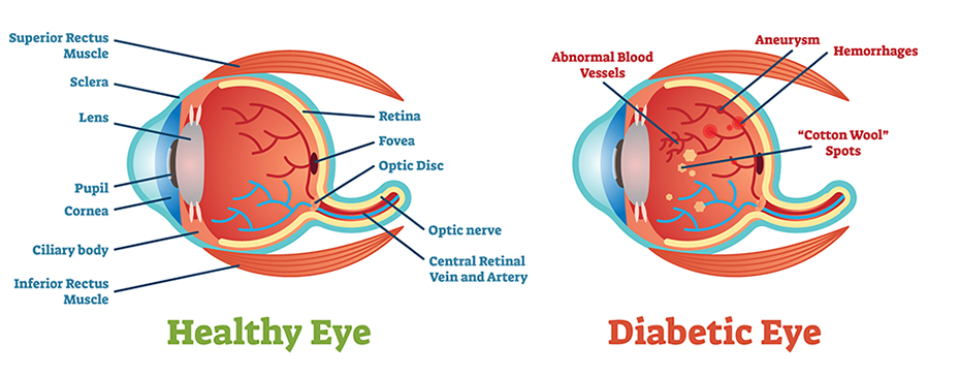
Diabetes retinopathy is the condition in which the retina is damaged, and it is a diabetic complication. When the glucose level in the blood is high, it causes a blockage in the blood vessels, causing the blood vessels to rupture easily. thus causing impaired vision and blindness (2, 3).
In the early stages, there are no significant symptoms associated with this problem; however, as things get more serious, people will experience seeing floaters or black dots in their vision. They will then start to experience obscure vision, night blindness, and diplopia (seeing a double image) (2, 3).
Risk factor to this problem includes those who have been diagnosed with diabetic in the long time (more than 5 years), those who have poor control of blood glucose level, cholesterol level, blood pressure level and low haemoglobin. Those who have gestational diabetes are also at high risk of getting diabetes retinopathy (2, 3).
There are two types of diabetic retinopathy (2,4);
Non – Proliferative Diabetic Retinopathy
Non-proliferative diabetic retinopathy (NPDR) is the early stage of the disease, in which symptoms will be mild or non-existent. In NPDR, the blood vessels in the retina are weakened. Tiny bulges in the blood vessels, called microaneurysms, may leak fluid into the retina. This leakage may lead to swelling of the macula.
Proliferative Diabetic Retinopathy
The more advanced form of the disease is proliferative diabetic retinopathy (PDR). Circulation issues deprive the retina of oxygen at this stage. As a result, new, vulnerable blood vessels can form in the retina and the vitreous, the gel-like fluid that fills the back of the eye. Blood from the new blood vessels may leak into the vitreous, clouding vision.
In order to prevent diabetic retinopathy from occurring, it is recommended for individuals with diabetes to control their blood sugar level, control their blood pressure level, stop smoking, regularly exercise, and maintain their ideal weight. Apart from these, people with diabetes may as well conduct yearly eye screenings. Eye screening for diabetics will be conducted using a fundus non-mydriatic camera, where an image of the eyes will be captured. Optometrist, eyes doctor, or eye specialist will then grade the image to see whether the eye's codition is normal or abnormal. Bleeding and swelling in the retina, an abnormal optic disk, a torn retina, and other abnormal conditions are examples of abnormal conditions.
References
- National Health Morbidity Survey (NHMS) 2019. Institute Kesihatan Umum (IKU), Kementerian Kesihatan Malaysia.
- Fatanah Ismail. Diabetes Mellitus (2008). MyHealth Portal. Kementerian Kesihatan Malaysia. http://www.myhealth.gov.my/en/diabetes-mellitus-3/ (Accessed on August 21, 2020).
- Ainayanti Adnan. Diabetis: Mesti Jalani Pemeriksaan Mata (2016). MyHealth Portal. Kementerian Kesihatan Malaysia. http://www.myhealth.gov.my/diabetes-mesti-jalani-pemeriksaan-mata/ (Accessed on August 21, 2020).
- Diabetic Retinopathy (n.d). American Optometric Association (AOA). https://www.aoa.org/healthy-eyes/eye-and-vision-conditions/diabetic-retinopathy?sso=y (Accessed on August 21, 2020).

Is artificial sweetener good for health?
Artificial sweeteners are low-calorie or calorie-free chemical substances used instead of sugar to sweeten foods and drinks. Sacharin, was the first artificial sweetener discovered in John Hopkin. It was then use widely, to the point that it was used during world war II when there was a sugar shortage, and when the shift in the perspective viewing thin figure as beauty. Sacharine is 300 times sweeter than sucrose but it has bitter after taste, which makes scientist discover cyclamate, aspartame and many more. As of 2018, there are eight Food and Drug Administration (FDA) approved artificial sweeteners which are, acesulfame K (Sunnet), aspartame (Nutrasweet), saccharin (Sweet and Low, Necta sweet), neotame (New tame), sucralose (Splenda), stevia (Truvia), advantame, and Luo Han Guo fruits extract (Nectresse).
With the advancement in the technology of discovering all these non-calorie artificial sweeteners, thousands of products ranging from drinks, desserts, ready to eat food, baby food, frozen food, and toothpaste start to use this non-calorie artificial sweeteners. But,
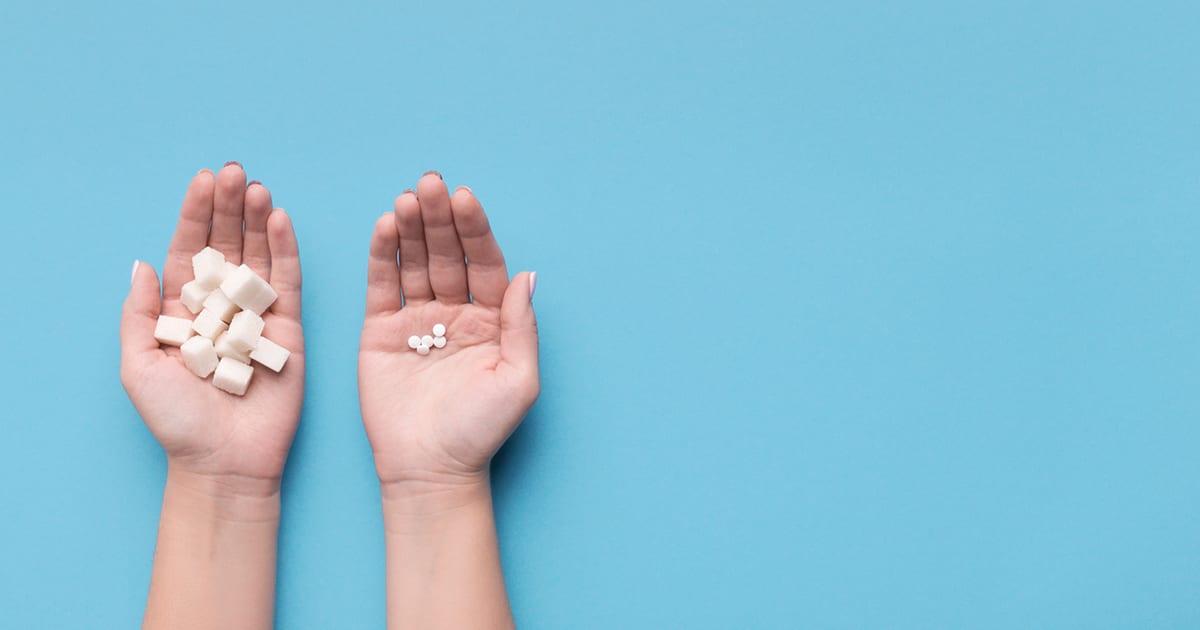
Is artificial sweetener healthy? (2, 4, 5)
Although it has been approved by FDA that it is safe to consume artificial sweeteners within the Acceptable Daily Intake (ADI), but the healthiness of artificial sweeteners is somewhat questionable though many individuals with diabetic are consuming it as a means to control their blood sugar level.
Several large-scale studies using artificial sweetener come up that the consumption of artificial sweeteners had no effect on energy intake unlike glucose or sucrose, when it does not possess any effect on the energy intake or consumption of food, it trigger a response to keep the overall energy consumption constant.
We can see this clearly in the rat model study, where rodent that is supplemented with saccharin had significantly elevated total energy intake and gain more weight with increase body adiposity (fat) compared to those that conditioned with glucose. It was seen that, rodent that was given saccharin consume more food than those that is not given saccharin.
While in the human studies, the San Antonio Heart Study that examined 3, 682 adult over seven to eight year period of time found out that BMI of those who consumed artificial sweetener is significantly increased as compared to those who do not. Nurses’ Health Study reported similar observation among children.
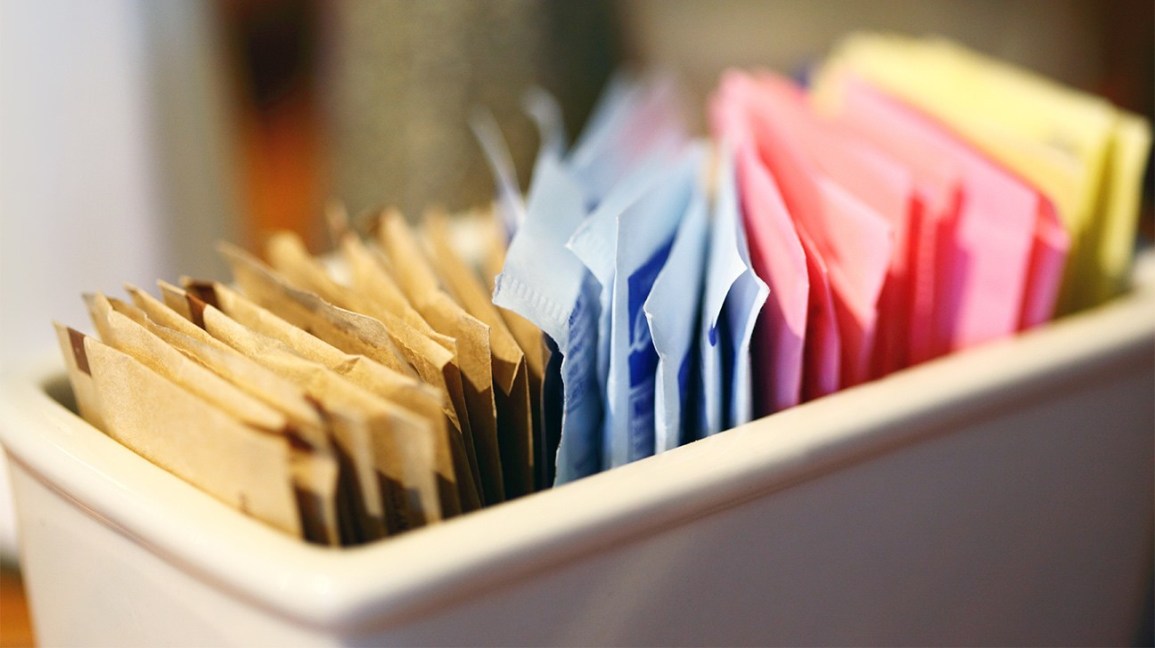
Why is that so? (2)
The explanation on this is owe to on how our brain function when we consume food. When we consume food, it is not only that our digestive system is activated but as well as our mind. Food reward system shares the same brain circuitry with other pleasurable activities such as sex and drug administration, thus share the same behavioural paradigm such as binging, withdrawal, and craving. Food rewards consist of two branches: sensory and postingestive (after eating). When we eat, our mind activates in order to tell our body that we are already full, or we feel full (satiety) or when we are satisfied with the food (mesolimbic dopamine system). Mesolimbic dopamine system is a system that is activated whenever a pleasant taste causes us to be satisfied with the food that we consumed.
However, when we consume food from artificial sweetener, it is somehow does not activate mind into signalling that we are satisfied with the food, thus those who consume artificial sweetener tend to consume more food, this trick has cause individuals to eat even more, some more thinking that they consume non-calorie artificial sweeteners, thus making them easily gain weight.
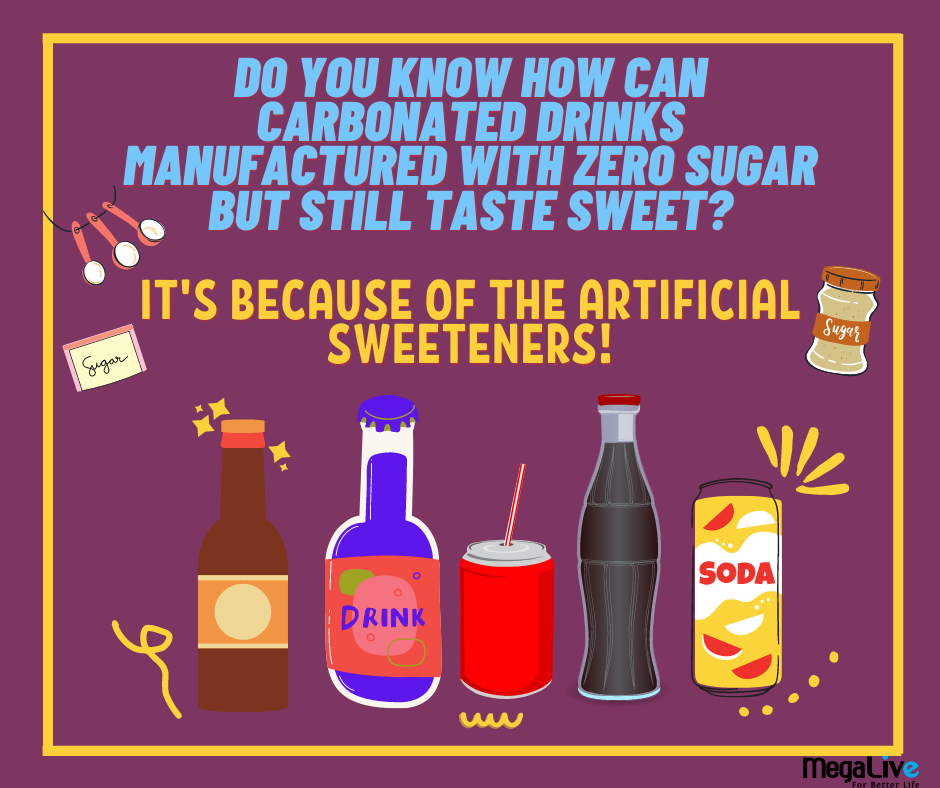
In conclusion (1)
Data on artificial sweeteners is still scarce as compared to other kind of things, where even health professionals have different take on whether it is okay for the body. To make thing safe, whatever things that we consume must always be in moderation, balance, and variety. It is very essential for individuals with diabetes to know on how to estimate their calorie intake and identify the food that can instantly spike their blood glucose level and food that will slowly increase the blood glucose level, so that they can manage their blood glucose better.
Different kind of artificial sweeteners have different level of sweetness as compared to sucrose; it also has different side effect in terms of its bitter after taste. Some of it even is not suitable to certain cooking temperature like baking. Some of it is even not suitable to certain medical condition such as phenylketonuria (PKU), a condition when an individual is unable to metabolize amino acid phenylalanine, thus cannot consume food that has phenylalanine such as aspartame.
Also, if you are considering taking artificial sweetener, do consult medical professional so they may calculate the amount needed based on your body weight per day.
References
- National Health Service (NHS). U.K. The Truth About Sweeteners. https://www.nhs.uk/live-well/eat-well/are-sweeteners-safe/ (Accessed on September 9, 2020).
- Qing Yang (2010). Gain weight by “going diet?” Artificial sweeteners and the neurobiology of sugar cravings. Department of Molecular, Cellular and Developmental Biology, Yale University. YALE JOURNAL OF BIOLOGY AND MEDICINE 83 (2010), pp. 101-108.
- S Food and Drugs Administration (FDA) (2018). Additional Information about High-Intensity Sweeteners Permitted for Use in Food in the United States. https://www.fda.gov/food/food-additives-petitions/additional-information-about-high-intensity-sweeteners-permitted-use-food-united-states (Accessed on September 9, 2020).
- Mc Clave, S., Obert, J., Casey, L. (2017). The Association Between Artificial Sweeteners and Obesity. Nutrition and Obesity. Current Gastroenterology Reports volume 19, Article number: 64 (2017).
- Brown, R. J., De Banate, M. A., & Rother, K. I. (2010). Artificial sweeteners: a systematic review of metabolic effects in youth. International Journal of Pediatric Obesity, 5(4), 305-312.

Do you know why fiber is important?
Fiber is a type of carbohydrate that our body is unable to digest. Though most carbohydrates are broken down into sugar molecules, fiber cannot be broken down into sugar molecules, and instead it passes through the body undigested. Fiber helps regulate sugars in the body and helps keep hunger and blood sugar in check.
Children and adults need at least 20 to 30 grammes of fiber per day for good health. It can be obtained by consuming a diet rich in whole grains, vegetables, legumes, nuts, and fruits.
There are two types of fiber: soluble fiber and insoluble fibre.
-
Soluble fiber is a type of fiber that dissolves in water and can help lower glucose levels and blood cholesterol levels. Foods with soluble fiber include oatmeal, nuts, beans, lentils, apples, and blueberries.
-
Insoluble fiber is a type of fiber that does not dissolve in water. It can help food move through the digestive system, promoting regularity and helping to prevent constipation. Foods with insoluble fibers are wheat, whole wheat bread, whole grain couscous, brown rice, legumes, carrots, cucumbers, and tomatoes.
There are various studies confirming that consumption of a diet high in fiber helps to make the overall body function healthier.
Heart Health
In a Harvard study with over 40, 000 male health professionals, researchers found that consumption of a high-fiber diet reduced the risk of getting coronary heart disease by 40%. Another study conducted by Harvard among female nurses also found similar findings: a high-fiber diet lowers the risk of metabolic syndrome (a combination factor of heart disease and diabetes). These factors are high blood pressure, high insulin levels, excess weight, a high triglyceride level, and a low HDL level (good cholesterol level).

Diabetes Mellitus Type 2.
A diet low in fiber and high in carbohydrates and fat can cause a sudden spike in blood sugar, which can increase the risk of developing type 2 diabetes. Both Harvard studies with female nurses and male health professionals found that this type of diet increased more than double the risk of type 2 diabetes.
Other studies, such as the Black Women’s Health Study and the European Prospective Investigation into Cancer and Nutrition, have shown similar results.
Constipation.
It is believed that the fibre in wheat bran and oat bran is more potent than the fibre found in fruits and vegetables. In addition, because fibre absorbs water, experts advise increasing beverage intake along with fibre intake rather than doing so abruptly.
Cancer.
Fiber is shown to decrease the risk of breast cancer through a large-scale study in 2016, where the findings indicate that higher fiber intake reduces breast cancer risk, suggesting that fiber intake during adolescence and early adulthood may be particularly important.
In other words, women who consume higher fiber foods during adolescence and young adulthood, including vegetables and fruits, may have a significantly lower breast cancer risk than those who eat less dietary fiber when young.
In conclusion, consumption of sufficient fiber can give various benefits to the human body. According to the Malaysia Food Pyramid 2020, it is recommended to consume 3 servings of vegetables and fruits daily. However, according to the National Health Morbidity Survey (NHMS), about 95% of Malaysians do not consume enough vegetables and fruits daily, which is why sometimes consumption of fiber supplements can help to bridge the gap of poor dietary intake.
Reference
1. Harvard T.H. Chan School of Public Health. Fiber. https://www.hsph.harvard.edu/nutritionsource/carbohydrates/fiber/
2. National Health and Morbidity Survey (NHMS) (2019). Chapter 09, Of fruits, veggies, and plain water. http://iptk.moh.gov.my/images/technical_report/2020/4_Infographic_Booklet_NHMS_2019_-_English.pdf
3. Malaysia Food Pyramid 2020. Ministry of Health Malaysia. Nutrition Division. http://nutrition.moh.gov.my/piramid-makanan-malaysia-2020-mendidik-rakyat-mengambil-makanan-dengan-betul/

Diet Suku – Suku Separuh ?
MegaLive menyambut baik saranan ini dengan turut sama mempromosikan amalan pemakanan sihat ini kepada semua.
Suku – suku separuh adalah diet yang merangkumi suku jumlah karbohidrat seperti nasi, mee, bihun, capati, roti dll, suku jumlah protein seperti ayam, ikan, sotong dll dan separuh jumlah sayur – sayuran dan buah – buahan. Pinggan yang dirujuk dalam saranan diet ini adalah pinggan berukuran 10 inci/ 25sm.
Contoh hidangan suku – suku separuh:
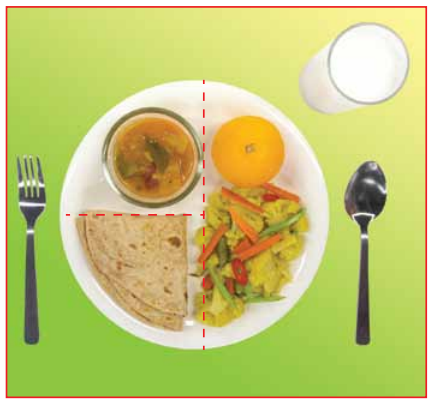
Capati dengan kuah dhal.
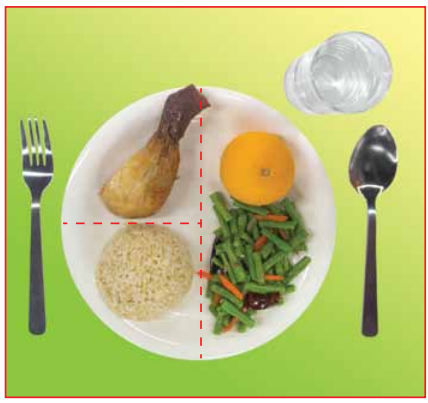
Nasi beras perang dengan ayam tanpa kulit dan sayur.
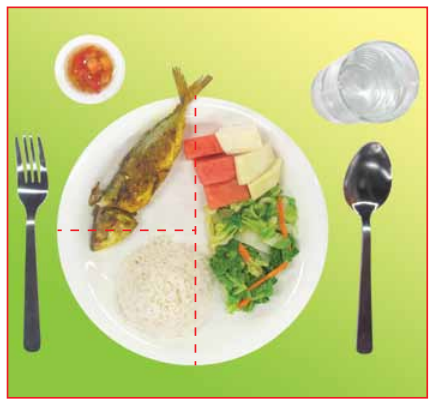
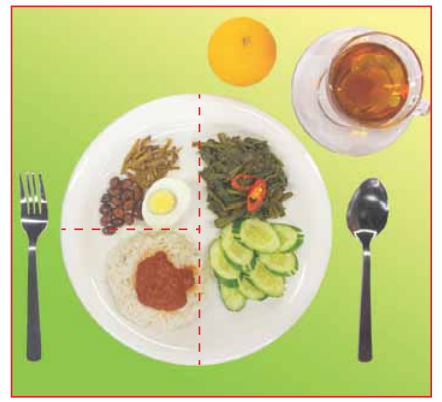
Nasi lemak

Terdapat 5 mesej utama dalam amalan diet suku – suku separuh.
Mesej Utama 1: Makan 3 Hidangan Utama yang sihat dalam sehari.
Makan sarapan, makan tengah hari, dan makan malam dengan sihat dengan mengikut konsep suku – suku separuh.
Makan pada waktu yang tetap juga membantu pengawalan porsi/ saiz hidangan makanan. Berikut adalah contoh waktu makan seharian.
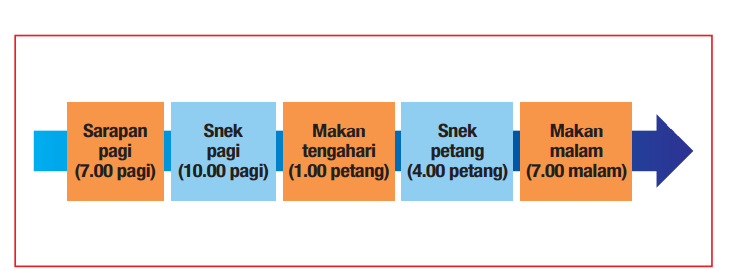
Mesej Utama 2: Makan 1-2 Snek yang Sihat di antara Waktu Makan Jika Perlu
Bagi menggalakan pemakanan secara sihat secara holistik atau sebagai gaya hidup, anda juga digalakkan untuk mengambil snek sihat 1-2 kali dari sumber buah – buahan, kekacang, dan sayur – sayuran.
Contoh snek sihat yang boleh di ambil 1-2 sajian ialah:
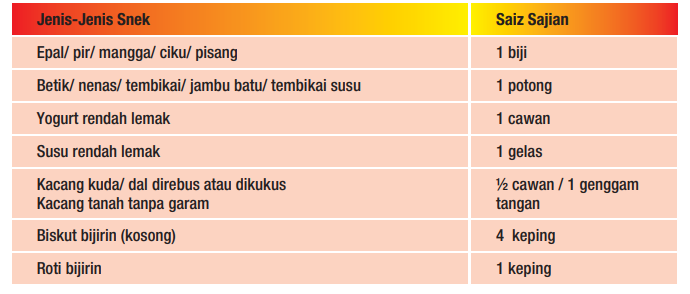
Mesej Utama 3: Makan Sekurang-kurangnya Separuh Daripada Bijirin Anda Sebagai Bijirin Penuh
Malaysia adalah negara di mana, makanan rujinya adalah nasi, oleh itu tidak hairanlah jika kebanyakkan rakyat Malaysia masih berasa tidak kenyang selagi tidak makan nasi. Oleh yang demikian, Kementerian Kesihatan Malaysia (KKM) menggariskan pengambilan karbohidrat hendaklah diambil kebanyakkannya dari sumber bijirin penuh, seperti dari sumber nasi beras perang, roti bijirin mil penuh, jagung, barli dll.
Contoh makanan berkarbohidrat yang tinggi serat:
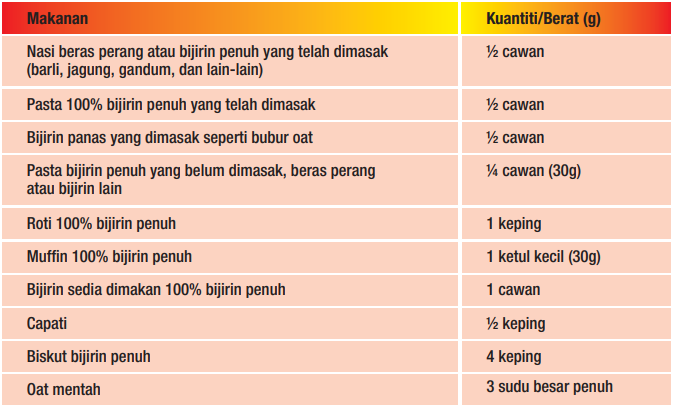
Mesej Utama 4: Makan Hidangan Tidak Bergoreng dan Tanpa Santan Setiap Hari
Seterusnya, lauk -pauk di Malaysia begitu sinonim sekali dengan jenis lauk -pauk yang bergoreng menggunakan minyak yang sangat banyak iaitu menggunakan kaedah ‘deep -frying’. Makanan bergoreng dengan minyak banyak yang digunakan secara berulang – ulang dan makanan yang mengandungi jumlah santan yang tinggi boleh meningkatkan masalah kesihatan seperti masalah jantung, darah tinggi, kolesterol dan kanser.
Justeru, pengambilan makanan dengan cara masakan dan kandungan santan yang tinggi seperti masak lemak, kari, gulai, dan masakkan bergoreng hendaklah dihadkan.
Cara mengantikan pengambilan minyak dan santan dalam masakan dan makanan:

Mesej Utama 5: Makan Makanan yang dimasak di Rumah Lebih Kerap
Makanan yang dibeli di luar secara amnya mempunyai kandungan gula, garam, sos, kicap, perasa, dan monosodium glutamate (MSG) yang tinggi, ia juga kebanyakannya menggunakan kaedah memasak yang kurang sihat iaitu dengan cara menggoreng dengan minyak yang banyak dan berulang- ulang.
Kandungan makanan yang tinggi garam, gula, sos, kicap, perasa dan MSG boleh menyebabkan tinggi risiko kepada masalah kesihatan seperti diabetes, dan juga darah tinggi.
Selain daripada itu, pengambilan makanan dari luar juga seringkali mempunyai jumlah porsi yang tidak mengikut spesifikasi suku – suku separuh, hal ini menyebabkan individu lebih cenderung untuk makaan secara berlebihan dan mendapat lebih risiko untuk menjadi obes.
Cadangan hidangan harian di rumah:

Rujukan:
- Kementerian Kesihatan Malaysia (KKM). Bahagian Pemakanan. Panduan Pinggan Sihat Malaysia. https://bit.ly/3HHHdU6

How to improve your blood circulation ?
Individuals with poor blood circulation typically experience numbness and coldness in their extremities, particularly their hands and feet. It is often the result of an underlying condition to a more serious condition, such as uncontrolled diabetes or low blood pressure, but it can also be the result of poor posture, among other things.
Here are some tips on how to
improve your blood circulation:
1. Go on regular walks
Walking can improve blood
circulation. Contraction of the calf muscle causes venous blood to be pushed
back up to the heart. The arteries dilate when patients walk and improve blood
flow throughout the body. Aim for a minimum of 30 minutes of walking three
times per week.
2.
Reduce your weight
Being obese or overweight poses a
greater health risk to your circulatory system because it increases your risk
of hypertension, high cholesterol, and diabetes, all of which lead to blood
circulatory problems.
Consumption of food in moderation,
balance and exercise regularly can help to prevent being obese and overweight.
3.
Take more breaks at work
Taking more work breaks allows you
to develop the habit of alternately sitting, standing, and walking. This
reduces the demand on the circulatory system because sitting causes blood flow
to slow and pool in your legs, resulting in muscle pain and fatigue. Thus,
taking more breaks while working in an office is beneficial for improving blood
flow and keeping your stress level in check.
Try to stretch every 15 to 20
minutes and get up and move every hour—even if it's just a power walk around
your house.
4. Stay
hydrated
When your body is dehydrated, it affects the amount of blood that
circulates through it. It also causes your blood to retain more sodium, causing
it to thicken and making it much more difficult for your circulatory system to
function properly.
Checking your pee is the simplest
way to ensure that you are getting enough fluid. A yellow light or clear urine
indicates that you are drinking enough water; anything darker indicates that
you need to up your water intake game!
5.
Manage your blood pressure
High blood pressure causes your blood circulation to go haywire,
putting more strain on your heart and blood vessels. If you do not manage your
blood pressure properly, the heart and circulatory system will have to work
harder to supply blood flow throughout the body.
High blood sugar levels can harm
the lining of small blood vessels, causing blood circulation issues. This
condition will also encourage the formation of plaque in your blood vessels,
further complicating matters.
Exercise, limiting sodium intake,
reducing stress, getting enough sleep, and making changes to your lifestyle can
all help to lower your blood pressure and improve your circulation. Ideally,
your blood pressure should be less than 120/80 mmHg.
6.
Elevate your legs.
Elevating your legs relieves
pressure on your veins because the blood does not have to work against gravity
to return to the heart.
When you are watching TV or taking
a nap, the most convenient time to elevate your legs is when you are lying down
and prop your legs above your heart level for 15 minutes or more at a time.
This will greatly improve overall blood circulation.





